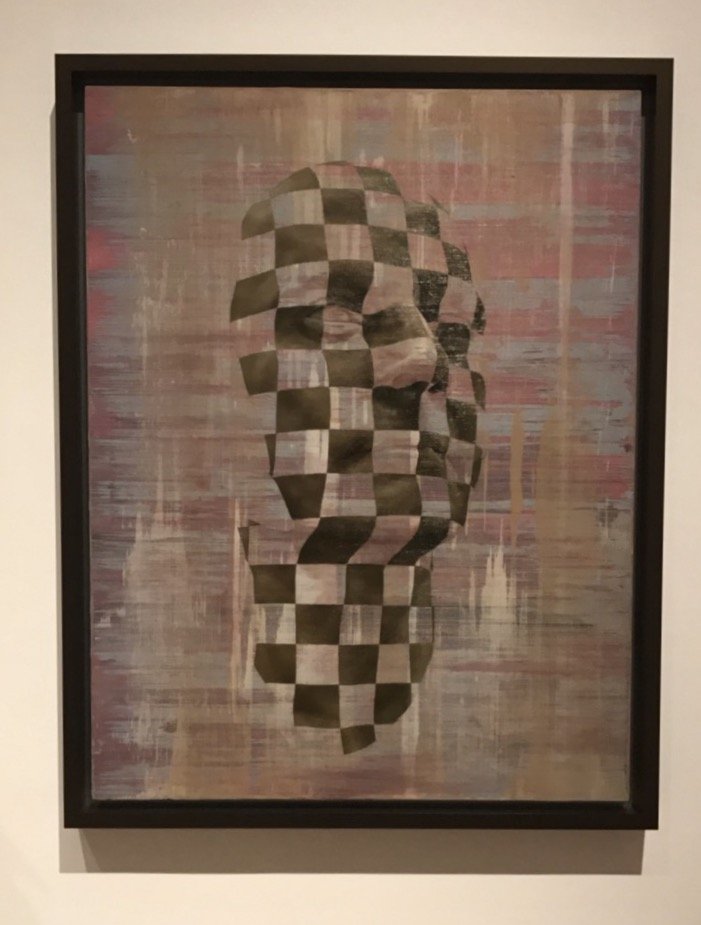Last December (2017) at the Royal Academy of Arts, on their top floor the exhibition "From Life" showcased and questioned "what it means to make art from life" and how that method may be developing.
Historically, life drawing for any art practitioner was often necessary. Especially for a portrait artist.
And yet, times are a changing....
Or times are evolving...
On display at the RA, towards the end of the show, were the artworks "The Simulacra" (Oil on Canvas 2017), "Homage to Paolozzi" (Bronze 2017) and "The Unteleported Man" (Oil on Canvas 2017), all by portrait artist Jonathan Yeo.
These artworks were made with the help of technology.
"Homage to Paolozzi" is the first sculpture designed with the virtual reality softwareGoogle Tilt Brush, and "The Simulacra" and "The Unteleported Man" paintings were aided by advanced 3D scanning.
For part of the artworks, Yeo used the LightStage scanner by OTOY technology, where he scanned his face and then transmitted that to the Tilt Brush software.
Pangolin Editions then reproduced the 3D brushstrokes, into bronze cast for the sculpture.
Partnering with Google Arts and Culture, Jonathan Yeo worked with Google engineers on the Tilt Brush Software.
Tilt Brush have also teamed up with various artists, cartoonists and animators, working with them on this new way of creating. Some of which have taken up an art residency with them.
Tilt Brush by Google was created to, as they state on their website, make us "Step Into Your Imagination", in other words, for us to step into our imagination and paint it in our 3D space and not just represent or recreate a 3D space on a flat surface.
[One day, we may be able to literally step into other people's imagination....] but leaving that thought aside, the technological art tool is meant to facilitate drawing and creating in 3D spaces and for the art experience to be able to take us on a journey. Through viewing some of the artists work online, it does feel like stepping into a world made of art, like an animated painting, or a painting being awoken into life.
The concept is pretty impressive and it opens up a whole area and genre of art.
Technology and this tool, also continues the fusing of graphics, print, animations with fine art, illustration and sculpture, and little by little there no longer may be a separation between the arts.
Or there no longer may be something called "digital art" it will just be art.
So should we be worried about technology engulfing the arts, or should we be in awe?
And is this just not the evolving nature of things, of life, and now of the art world.
After all innovation includes the invention of masking tape used in art, or photoshop, not forgetting the ever so practical, repeat pattern buttons or copy and paste on our computers, to now, this innovation, where it is at with painting in 3D space.
Only time will tell if artists will want to experiment with 3D painting or not.
Sometimes the materials used in art are about a trend. When photography was invented, or became very popular, many thought that would be the end of painting. And yet, paint lives on. Paint has also had its fair share of innovation, it is of course more synthetic now.
So painting despite all the other arts has lived on, because there is something to be said about a practice that is bound by time and observation.
The new medium of drawing in virtual reality, where a person as they paint can walk inside their artwork and that the artwork can surround the artist, feels like looking at an innovation taking us into a new world.
Albeit, a world made in art.
So can this tool create artists of us all? And what would that mean?
What will this mean for Street Art?
Could you imagine walking around with paintings floating around us?
Many thoughts come up while looking at this wondrous new art tool.
This technological progression, is that - a progression, and in time, the now of art, will become the norm of art and then, once it is a norm, a new type of tool for art will be invented.
It's not just technology that is disruptive, so is art. Art at some level, at some point in time, is meant to disrupt.
So either both disciplines of technology and art together will disturb or they will create wonders.
Or will do both.
The customer or the audience will decide.
Through this type of 3D technology, assuming it could be available to many or to many artists, could this new 3D art paint be used in a positive light and build virtual bridges between communities, between different areas of a city to bring us closer?
Or will this new type of art, be like in Greek Methology, the tool that opens pandora's box...

The Simulacra 2017 by Jonathan Yeo (Oil on Canvas) (artwork pictured at the Royal Academy)

Homage to Paolozzi 2017 (Self-Portrait) by Jonathan Yeo (Bronze) (artwork pictured at the Royal Academy)

The Unteleported Man 2017 by Jonathan Yeo (artwork pictured at the Royal Academy)
